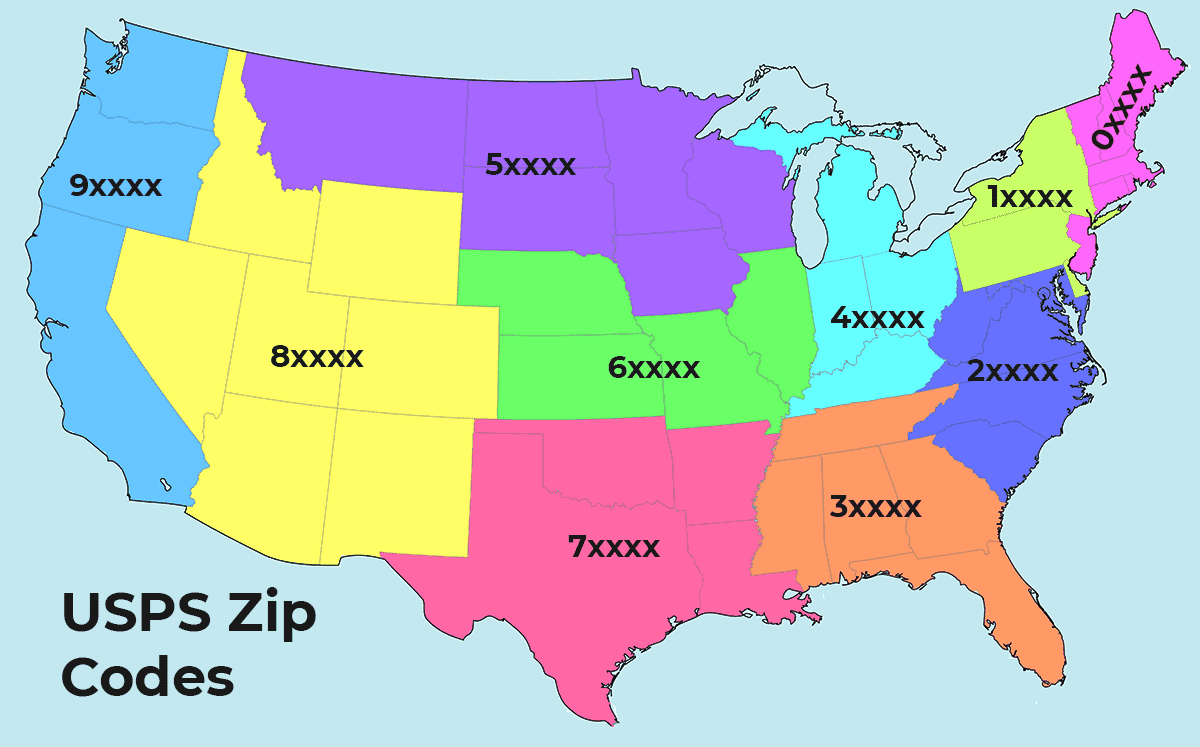Everything you ever wanted to know about Zip Codes
What is the 5 digit zip code?
ZIP Codes designate delivery routes and areas. The USPS uses zip codes to make it easier to route and deliver your mail. Is that it? Of course not, we have more below.
The "ZIP" in Zip Code stands for "Zone Improvement Plan". A ZIP Code indicates the destination post office or delivery area to which a letter will be sent for final sorting for delivery.
What Are Zip Codes? and how do they work?
There are three main parts to the 5-digit ZIP Code as designated by the USPS. The national area, the city or region, and the delivery area. The United States Postal Service (USPS) has segmented the country into 10 ZIP Code areas. Starting in the northeast, they are numbered 0-9.
This map below shows each ZIP Code's region:

The first digit of the ZIP Code is allocated as follows:
| First Number of Zip Code is: | States and Territories |
|---|---|
| 0 | Connecticut, Massachusetts, Maine, New Hampshire, New Jersey, Puerto Rico, Rhode Island, Vermont, Virgin Islands, Army Post Office Europe, Fleet Post Office Europe |
| 1 | Delaware, New York, Pennsylvania |
| 2 | District of Columbia, Maryland, North Carolina, South Carolina, Virginia, West Virginia |
| 3 | Alabama, Florida, Georgia, Mississippi, Tennessee, Army Post Office Americas, Fleet Post Office Americas |
| 4 | Indiana, Kentucky, Michigan, Ohio |
| 5 | Iowa, Minnesota, Montana, North Dakota, South Dakota, Wisconsin |
| 6 | Illinois, Kansas, Missouri, Nebraska |
| 7 | Arkansas, Louisiana, Oklahoma, Texas |
| 8 | Arizona, Colorado, Idaho, New Mexico, Nevada, Utah, Wyoming |
| 9 | Alaska, American Samoa, California, Guam, Hawaii, Marshall Islands, Federated States of Micronesia, Northern Mariana Islands, Oregon, Palau, Washington, Army Post Office Pacific, Fleet Post Office Pacific |
The second digits are allocated as follows:
Secondly, the USPS assigns the next two numbers according to city or region. Most regions have a main city or town, in this case the USPS will assign it the first ZIP Codes. After that, the ZIP Codes will proceed alphabetically.
Third set of digits:
The fourth and fifth digits of the ZIP Code represent the area of the city or town. For example, if a letter is received with a ZIP Code of 92019, the USPS can know that it's in California (9), it's in San Diego county (20), and it's in the area of El Cajon (19).
Zip Codes are drawn as lines, Not as Shapes
Zip Codes are not drawn according to county or state boundaries. Since Zip Codes are designed to increase mailing efficiency, they can and often do cross county and state boundaries.
This is one reason it is important to always have current and accurate zip code data just like we provide at Zipcodedownload.com.
What are Zip+4 Codes?
In 1983, the U.S. Postal Service introduced an expanded ZIP Code system that it called ZIP+4. A ZIP+4 Code uses the basic five-digit code plus four additional digits to identify a geographic segment within the five-digit delivery area, such as a city block, a street or an office building, a post office box, or any other unit that could use an extra identifier to aid in efficient mail sorting and delivery. A ZIP+4 Code is not required to deliver mail although it speeds up the process.
Our Products
- US Zip Code Database
- US Zip+4 Database
- Multi County Database
- Canadian Postal Code
- 2010 Census Database
- Zip Code API
- Area Code Database
- NPA NXX Database
- Congressional District Database
- Sales & Use Tax Database
- Health Care Coverage Database
- CBSA Medicare Database
- Statistical Databases
- Mexico Data
- Canada Area Code Database
ZIPCODE DATA SINCE 2002
- USA Product Comparison
- Canada Product Comparison
- Free ZIP Code Finder
- Competitor Evaluation
- Case Studies
- What Can Our Data Do For You?
- Why Is Our Data More Accurate?
- Who Are Our Customers?
- Why Choose Us?
- Zip Code Database
- Postal Code Database
- Free Zip Code Database
- Free Vs Paid Zip Code Database
- Free Zip Code Tools
- Our ZIP Code API
- What is the 5-digit Zip Code?
- USPS Zip Code Database Download
- How to purchase a United States postal service Zip Code Database